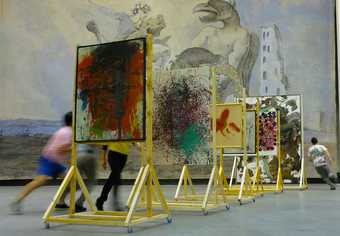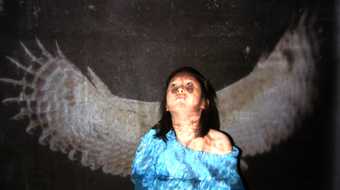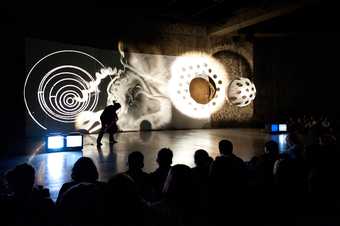
Ei Arakawa See Weeds 2011
New York based Japanese artist Ei Arakawa takes up a week long residency in the Tanks and invites Supreme Connections to take a further week’s residency.
°Â±đ±đ°ěĚý1
Slide shows of works by artists Silke Otto-Knapp and Florian Pumhösl will be projected on to the walls of the Tanks, alongside a large scale reproduction of Jutta Koether’s painting La Femme, to provide a theatrical backdrop for the week’s series of collaborative performances and actions. Inspired by Arakawa’s research into the Jikken Kobo and Gutai groups whose activities took place in the 1950s in post-war Japan, exploring performance and cross-disciplinary action.
During the week you are invited to join Arakawa for JOY OF LIFE, an art historical workshop with Harumi Nishizawa and Miwako Tezuka; the new generation of Japanese art historians of the pre and post-War period, exploring the relationship between art and theatre in the 1920s, early ballet productions in Japan, pre-Gutai Gutai and Jikken Kobo.
Evening events include SINGLE’S NIGHT a participatory, free event where singles are invited to dance with Jutta Koether’s work Mad Garland, accompanied by sensual music provided by Stefan Tcherepnin, a screening of Fukushima Hula Girls (2012), a film about hula girls in Fukushima amidst the post-earthquake confusion, accompanied by a dance with new glass paintings by Kerstin Brätsch, and Kissing The Canvas, Arakawa’s non-dance dance performance, which actively utilizes Jutta Koether’s La Femme theatrical backdrop as a central actor within the piece.
- Download the residency programme notes (PDF, 812 KB)
Week 2
Supreme Connections is a collective model for interpreting and expanding upon the work of the American composer Maryanne Amacher (1938–2009).
From the 1960s onwards, Amacher’s practice explored listening perception, architectural acoustics, and narrative often inspired by the latest scientific discoveries and science fiction. Her work took the form of concerts, large-scale installations, projects for radio and television, texts, and many highly imaginative unrealised proposals.
During this week long residency Supreme Connections (Bill Dietz, Micah Silver, Stefan Tcherepnin, Robert The) explore Amacher's audio and visual materials, her methods of 'staging' and present the results of this experimentation with the process open to the public. The programme includes a panel discussion with Supreme Connections artists and Axel Wieder, Curator of Exhibitions at Arnolfini Bristol.
The first Supreme Connections iteration was produced in July 2012 under the auspices of the Berliner KĂĽnstlerprogramm of the DAAD along with the exhibition Maryanne Amacher: Intelligent Life, curated by Axel Wieder, Bill Dietz, Micah Silver, and Robert The, ongoing until 25 August 2012.
Maryanne Amacher (1938–2009) counts amongst the most influential figures in contemporary music. Amacher studied in the 1960s with Karlheinz Stockhausen and, in the 1970s and 1980s, she worked together with John Cage and Merce Cunningham and was a fellow at the Center for Advanced Visual Studies at MIT in Cambridge, Massachusets, USA. Amacher's work experiments with relationships between sound and space, and explores the physiological conditions of hearing.
- Download the residency programme notes (PDF, 528 KB)
Week 2 Schedule:
Friday 3 August
Panel discussion with Supreme Connections artists and Axel Wieder, Curator of Exhibitions at Arnolfini Bristol.
Saturday 5 and Sunday 5 August
Sounds screenings (presented every 2 hours)
This film file is broken and is being removed. Sorry for any inconvenience this causes.
The Tanks: Ei Arakawa
Part of the series The Tanks: Art in Action


